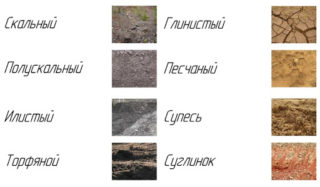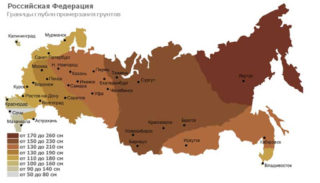A solid, reliable base is the key to the durability of any building. For the construction of houses, the types of foundations are chosen that correspond to the size, geometry and mass of the house. The design should be appropriate for the type of soil on the site, hydrological and climatic conditions.
Building structure functions
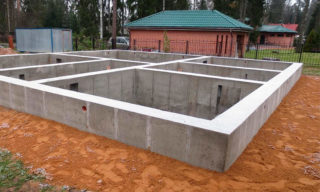
The foundation is the foundation on which the main part of the building is placed - enclosing, bearing and interior walls, bridge supports, overpasses.
Fundamental foundations are equipped for capital structures, which perform the following tasks:
- Distribute the weight of the building evenly over the surface of the site. Do not let the more massive parts sag more than the lungs.
- Create a flat horizontal base for the walls.
- Prevent moisture from entering the basement or technical floor.
- Preserve some of the heat from leaking into the ground.
- Prevent drift on heavy heaving soils.
- Protect buildings from destruction in seismically active areas.
Capital foundations are arranged for bridges and overpasses, advertising structures and oil product tanks, silos and bunkers.
Influence of soil on the choice of foundation
Important characteristics of the land:
- mechanical (geological) composition;
- freezing depth;
- maximum and minimum groundwater level;
- seismic situation in the area.
The choice of the type of foundation depends on the combination of soil properties.
Mechanical composition
Builders distinguish between soils:
- Stony. They contain a minimum of moisture, are resistant to heaving, and retain their properties when climatic conditions change. Suitable for shallow foundations.
- Sandy ones are easy to work out. The water does not retain, which reduces the cost of waterproofing. The freezing depth in the Central zone of the country does not exceed 1 meter, which allows the use of most types of foundations.
- Cartilaginous contain sand, clay, earth and crushed stone. Resistant to heaving. Suitable for any buried base.
- Loams with varying proportions of clay and sand. A higher clay content can contribute to heaving, imposes increased requirements on the preparation of the pillow, waterproofing, installation of the blind area.
- Clay require careful attention to site preparation. Not suitable for shallow foundations, as they freeze over more than 1.5 meters and change shape (swell).
- Peat is always prepared. If necessary, peat is removed and new soil is brought in. Houses built without preliminary measures can be "occupied" in the soil.
You can find out what kind of soil is on the site only during geological study or by methods of making pits, digging a pit. Even in adjacent areas, the composition and properties may vary.
Freezing depth
The bases are made either below the freezing depth, or shallowly deepened with the preparation of the place according to technologies.
Humidity and groundwater
If the water rises to the surface of the ground, the house is built without basements, using a slab or shallow foundation.
Moisture permeates the foundation material and can lead to rapid destruction of the building structure.
Base classification
Conventionally, all types of bases are divided into load-bearing, combined, special.
Carrier the type perceives and evenly distributes the load.
Combined species are used on heavy, floating ground. The base compensates for horizontal and vertical movements of the earth layers, resists seismic phenomena.
TO special include swinging and floating foundations, as well as foundations that distribute part of the load through the side walls and ends. This type includes deep supports, shell piles, pillars, drop wells, caissons, anchor and slotted designs.
Types of structures
Foundations are:
- tape;
- columnar;
- pile;
- slab;
- continuous.
In some cases, different technologies are combined. The reason may be complex soils, number of storeys, seismic conditions, requirements for resistance.
Tape
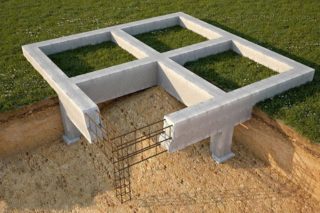
The foundation passes at the location of the load-bearing walls and partitions.
Distinguish between prefabricated and monolithic reinforced concrete structures.
The deep setting allows for basements and basements.
A trench up to 80 cm deep is dug under the shallow foundations. Sand is poured onto the bottom and along the side walls of the tape. Pillows prevent the destruction of the base in the winter from heaving of the soil.
In houses with basements, a monolithic tape and walls from separate blocks are combined.
The strip foundation is suitable for the construction of buildings of any height, geometry, mass.
Columnar
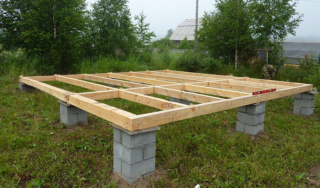
Columnar foundations are used for structures of small mass. Supports made of wood, concrete, metal are buried to the level of freezing.
The upper heads of the pillars are connected with a grillage.
For small structures, posts are built from ceramic bricks or concrete blocks. Rubble and concrete pillars are made by pouring.
Columnar bases are suitable for heaving lands and places with high groundwater.
Pile
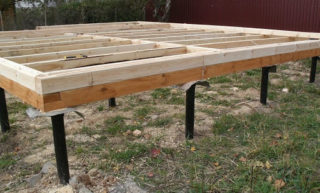
Foundations on piles are installed on soils that can be compressed and peat bogs with a depth of more than 4–6 m.
Piles are:
- Hanging - located in the thickness of the soft rock, not reaching hard soils. The load is transferred to vertical planes. The lower end sometimes has a helical thread with wide blades, which makes the base more stable.
- Standing piles run through the entire thickness of the light soil and rest on a solid foundation.
According to the installation technology, they are driven or rammed.
In the first version, a finished metal, concrete or wooden pile is driven into the hammer with special devices or mechanisms. As it deepens, the soil around the product is compacted, which makes the base stable.
For rammed models, a pit is made in the ground, which is clogged with concrete mortar.
Places of application of the pile foundation:
- peat areas and subsidence soils;
- quicksand;
- swamps;
- slopes.
At the last stage, the ground part of the piles is leveled and connected with a grillage.
Screw piles up to 1.5 meters long are used for small buildings.
Platen
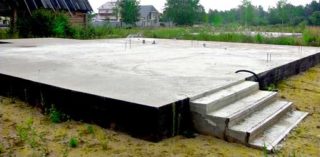
The slab foundation is a solid monolithic reinforced concrete platform, which is equipped under the entire area of the future building.
On stone and granite foundations, the construction is impractical and unprofitable.
Technological holes for communications are left at the stage of pouring. Before the start of work, water supply and sewerage pipes are laid.
Continuous
Continuous foundations are designed for tall, heavy structures, monuments, bridge piers.
The structure has several levels and is similar in shape to a pyramid; it combines elements of columnar, tape-type slabs.
Continuous types of foundations are redundant in properties for private construction and are rarely used.
Foundation materials
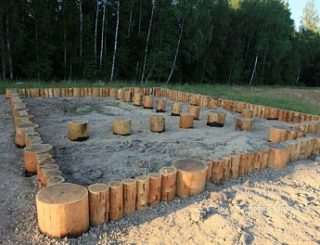
For construction, a variety of materials are used that are resistant to the effects of climatic factors.
Wood
The device of foundations made of wood is advisable when erecting houses from a bar or cylindrical logs, frame buildings.
It is advisable to use larch, which does not rot and serves up to 50 years even in wet soil. Oak is used less often due to its high cost, moreover, wood of this species cracks quickly.
The tree is suitable for columnar (pile) and strip foundations.
The advantages of wooden bases include a low price, quick construction. The repair consists in replacing the crown. Sometimes not the whole beam is replaced, but an insert (cut-in) of a part of a worn-out log is made.
Wood withstands deformation and poorly transmits heat.
The disadvantage is the short turnaround time due to the rapid destruction of wood under the influence of moisture - a high-quality treatment with water-repellent and antifungal impregnations is required. Do not use wood in houses with basements. The low bearing capacity does not allow the construction of massive multi-storey buildings and other structures.
A rock
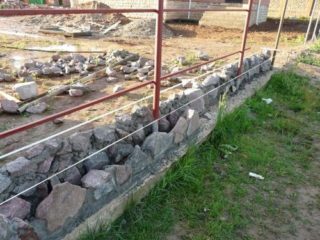
Stone types of foundations used in construction are made from the following materials:
- rubble rock - limestone, calcareous tuff, granite, dolomite;
- ceramic bricks;
- concrete blocks.
Natural rubble is divided into several types: ragged (uneven edges), cobblestone (rounded), bedded with two parallel edges and flat flagstone.
The technology consists in laying individual foundation elements with filling the joints with cement-sand mortar.
Tape and columnar bases are built of stone.
Pluses of stone foundations:
- increased strength and bearing capacity;
- environmental friendliness;
- long service life;
- resistance to temperature extremes and high humidity.
The complexity of the construction and a large amount of manual labor, the complex painstaking adjustment of individual stones to the configuration of the foundation, unsuitability for multi-storey buildings are the disadvantages of using the material.
Prefabricated foundations are made of FBS (building blocks). They are made from concrete or expanded clay concrete.
Reinforced concrete
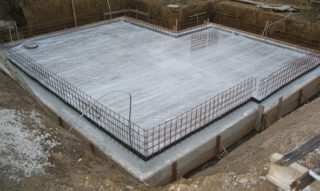
Concrete reinforced with steel and composite reinforcement is called reinforced concrete.
Composite reinforcement is not intended for the manufacture of foundations.
The composition includes sand, cement, crushed stone and additives that improve physical and mechanical characteristics. These additives include plasticizers and formulations for working at low temperatures.
For small buildings, it is allowed to use expanded clay concrete. It is important to protect the part of the foundation that is in the ground from moisture. This is achieved by equipping the blind area and waterproofing the outer walls.
Concrete is used to build tape, columnar, slab, and driven types of bases.
Advantages of concrete:
- manufacturability;
- strength, ability to withstand any load;
- the ability to give the base any geometric shape;
- availability for sale of a ready-to-use composition of any brands;
- resistance to any climatic conditions;
- resistance to moisture;
- simplicity of finishing (if necessary).
The disadvantages of reinforced concrete include the need to withstand the period before the strength gain, labor intensity and difficulties in maintaining proportions in self-production.
Foam concrete

A new material with improved consumer properties - aerated concrete is used for private houses and public buildings. The maximum building height should not exceed three floors.
Foam concrete is not used for pouring monolithic bases. Prefabricated foundations are erected from ready-made blocks.
Aerated concrete is divided into several density classes. The specific gravity varies from 300 to 1200 kg / m3.
Blocks are dried naturally or autoclave. For the bases, products made by the second method are selected.
For the construction of the foundation, only structural foam concrete with a density of D1000 – D1200 is suitable.
Material advantages:
- low thermal conductivity;
- mechanical strength with the correct choice of density;
- precise geometry;
- easy processing and cutting at home;
- durability, resistance to the spread of fungus and rot.
Disadvantages are related to material properties:
- cellular, porous structure facilitates the penetration of moisture into the block;
- multiple cycles of wetting-drying quickly destroy the material;
- impossibility of erecting multi-storey buildings;
- the need for high-quality waterproofing.
The main distribution of aerated concrete blocks was obtained during the construction of houses from foam concrete. This is convenient when ordering and delivering building materials that are manufactured at the same enterprise.
It is better to entrust the calculation of the foundation to specialists if the building has non-standard architectural solutions. Focusing on the parameters of the soil, hydrological features of the terrain, the mass of the building, you can make the foundation yourself. Compliance with the rules of arrangement will ensure the integrity of the building for the entire period of operation.

